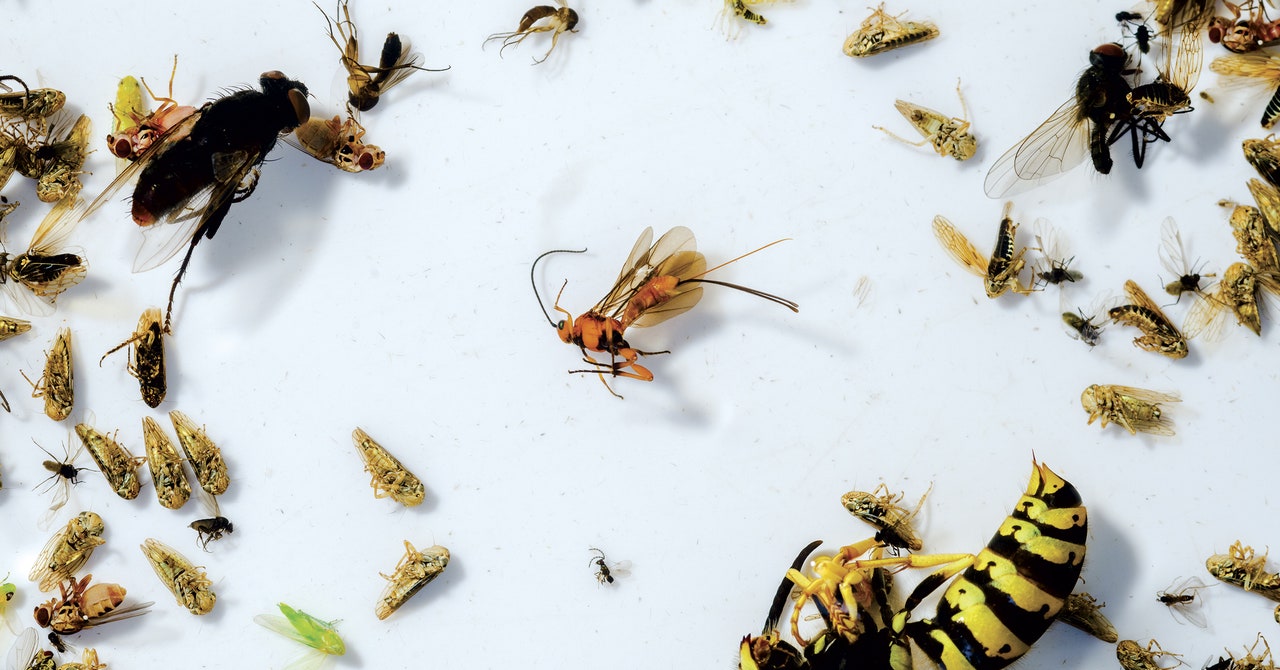
the bottle held a thin broth, light brown, with some uncertain chunks of dark matter bobbing on top—a soup, maybe, but one that you’d never want to eat. Once it was poured into a white plastic tray, the chunks resolved into insects. Here were butterflies and moths, the delicate patterns of their wings dimmed after a week or two in ethanol. Here were beetles and bumblebees and lots of burly-looking flies, all heaped together, plus a bevy of large wasps, their stripes and stingers still bright.
Michael Sharkey took out a pair of thin forceps and began examining his catch. It included anything small and winged that lived in the meadows and forests around his house, high in the Colorado Rockies, and that had suffered the misfortune, in the previous two weeks, of flying into the tent-shaped malaise trap he had erected in front of his home and we had emptied earlier that morning.
Though Sharkey is a hymenopterist, an expert on the insect order that includes wasps, he ignored the obvious stripes and stingers. He ignored, in fact, all of the creatures the average person might recognize as wasps—or even recognize at all. Instead, he began pulling little brown specks out of the soup, peering at them through a pair of specialized glasses with a magnifying loupe of the sort a jeweler might wear. Dried off and placed under the microscope on his desk, the first speck revealed itself to be an entire, perfect insect with long, jointed antennae and delicately filigreed wings. This was a braconid wasp, part of a family of creatures that Sharkey has been studying for decades. Entomologists believe that there are tens of thousands of species of braconid sharing this planet, having all sorts of important impacts on the environments around them. But most humans have probably never heard of them, much less been aware of seeing one. Huge parts of the braconid family tree are, as the saying goes, still unknown to science.
As a taxonomist, Sharkey is part of a small group of people who can transform anonymous insects into known species. When other entomologists find specimens they think may not yet have been named, taxonomists are the specialists they call in to investigate whether this seemingly new-to-us thing is actually new to us. If it is, the taxonomist may formally welcome it into the realm of human knowledge by publicly conferring upon the species a Latin name, along with an official description of the physical characteristics that make it unique and identifiable for future observers. The process “hasn’t changed an awful lot” in the past 200 years, the British hymenopterist Gavin Broad told me—except that nowadays “we’ve got nicer pictures.”
I first encountered Sharkey’s name months before I called him up and asked if we could look at bugs together. I don’t remember precisely when, only that I gradually started to notice the name—always followed by “et al.”—in more and more places. There were long critiques of Sharkey et al. appearing in scientific journals, and then, later, there were responses to those critiques, and responses to those responses. And then there was the snark among the entomologists in my Twitter feed, some of whom called the work irresponsible or embarrassing or just wrote “Wooooooof.”
“Sharkey et al.” is shorthand for a paper that came out in the journal ZooKeys in 2021, along with a series of subsequent publications that used similar methods. That first paper wasn’t the sort of work that usually raises such a hubbub. In it, Sharkey and a group of coauthors named some new species of braconid wasp that had been caught in malaise traps in Costa Rica. But instead of identifying just a few species, they named 403. And instead of writing up detailed descriptions for each new wasp, the authors simply included a photo and a snippet of genetic code.
The technique that Sharkey and his coauthors used, called DNA barcoding, is a way of quickly sorting and differentiating species. Researchers analyze a small section of DNA at a particular site in each creature’s genome, upload that sequence into a vast database, and then use algorithms to sort the different sequences into groups. When the DNA varies from one organism to the next by more than a few percent, it’s considered a sign that their evolutionary histories have gone down separate tracks for a significant period of time, possibly dividing them into different species.
DNA barcoding is a common scientific tool these days. But some scientists said that Sharkey and his colleagues had pushed its use too far. They deemed the work “turbo taxonomy” or even, as the taxonomist Miles Zhang said, “taxonomic vandalism,” a term for labeling taxa as new without sufficient evidence for their uniqueness. These critics argued that the work could undermine the whole project of naming the natural world, of beginning to make it legible to human understanding. Zhang—who is actually Sharkey’s academic “grandson,” having studied under one of Sharkey’s former students—was so frustrated that ZooKeys continued to publish papers from Sharkey et al. that he tweeted to the journal, “I’m done with you, go find a new subject editor.”


